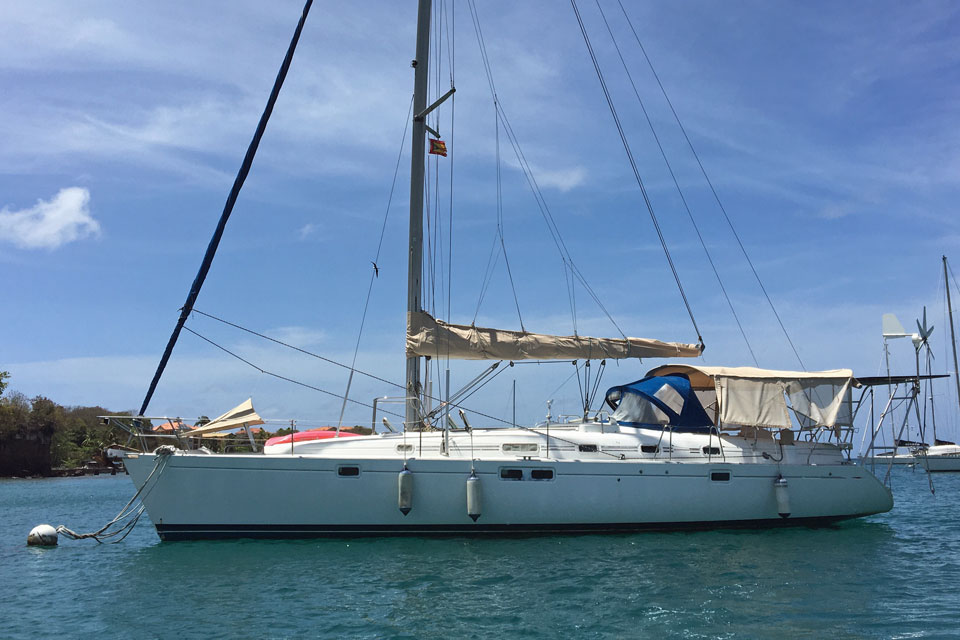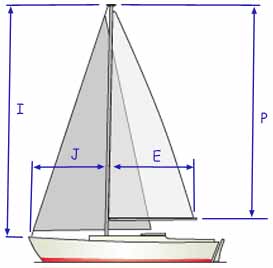- Home
- Cruising Yachts 45' to 50'
- Beneteau 461 Sailboat Specs
The Beneteau 461 Sailboat
Specs & Key Performance Indicators
The Beneteau 461 sailboat, a masthead sloop designed by Bruce Farr, was built by Beneteau, a French company headquartered in Saint-Gilles-Croix-de-Vie, France. She's also known as the Oceanis 461 or the Oceanis 'Clipper' 461.

Published Specification for the Beneteau 461
Keel & Rudder Configuration: Fin keel with a weighted bulb, spade-type rudder
Hull Material: Glassfibre (solid fibreglass hull, balsa-cored deck)
Length Overall: 46'7" (14.20m)
Waterline Length: 39'4" (12.00m)
Beam: 14'0" (4.25m)
Draft: 5'9" (1.75m)
Rig Type: Masthead sloop
Displacement: 20,944 lb (9,500 kg)
Ballast: 7,496 lb (3,400 kg) cast iron
Water Tank Capacity: 145 US gallons (550 litres)
Fuel Tank Capacity: 53 US gallons (200 litres)
Hull Speed: 8.4 knots
Designer: Bruce Farr
Builder: Beneteau
Year First Built: 1996
Year Last Built: 2001
Number Built: 210
Options & Alternatives
Draft: The Beneteau 461 was available with two draft options: a standard draft of 5'9" (1.75m) and a deep draft version drawing 6'9" (2.05m). This deeper keel provides better upwind performance and stability, especially in rougher seas.
Interior Layouts: There were multiple interior layout options to cater to different needs. These typically included configurations for two, three or four cabins.
Sail Areas & Rig Dimensions

I: 54'6" (16.62 m)
J: 15'11" (4.86 m)
P: 46'11" (14.30 m)
E: 17'1" (5.20 m)
Mainsail Area: 473ft2 (43.9m2)
Genoa Area: 617ft2 (57.3m2)
Upwind Sail Area: 1,089ft2 (101.2m2)
Published Design Ratios
The Key Performance Indicators (KPIs)
- Sail Area/Displacement Ratio: 16.7
- Ballast/Displacement Ratio: 32%
- Displacement/Length Ratio: 180
- Comfort Ratio: 28
- Capsize Screening Formula:2.0
The following analysis of the design ratios gives an indication of the boat's likely sailing characteristics, but see the 'Notes of Caution' below:
1. With a Sail Area/Displacement Ratio of 16.7, the Beneteau 461 falls within the range indicating reasonably good performance. This means the boat has sufficient sail power to perform well in various wind conditions, striking a balance between being underpowered and having high performance.
2. A Ballast/Displacement Ratio of 32% suggests that while the boat has a moderate amount of ballast, it is designed more for a balance between stability and performance rather than being extremely stiff. This is typical for a performance cruiser where moderate stability is preferred to enhance overall sailing experience without extreme stiffness.
3. The Displacement/Length Ratio of 180 places the Beneteau 461 at the upper end of the Light Displacement category (100-200). Boats with light displacement require less sail area to reach their hull speed, making the boat relatively easier to handle and quicker to accelerate, enhancing its overall performance while maintaining good responsiveness.
4. With a Comfort Ratio of 28, the boat is likely to have a somewhat lively motion, which is usually associated with coastal cruisers that have moderate stability. This suggests that while the Beneteau 461 offers reasonable comfort, it might have a more active motion in rougher seas compared to heavier bluewater cruisers, but will be quite comfortable for coastal and moderate offshore cruising.
5. A Capsize Screening Formula value of 2.0 puts the Beneteau 461 right on the threshold, indicating it's considered suitable for ocean passages. Being at the higher limit of the desired range for bluewater capability, it indicates that while the boat can handle offshore conditions, it might not be as stable as boats with a lower CSF value.
Summary:
The Beneteau 461 is a well-balanced performance cruiser with good sail power and manageable displacement that caters to both coastal cruising and moderate offshore passages. Its moderate ballast provides sufficient stability without compromising performance, while its comfort ratio suggests good livability in typical cruising conditions. The CSF of 2.0 confirms its capability for ocean passages, though it would be most comfortable in coastal to moderate offshore environments.
Here's how to calculate the KPIs yourself - without having to wrestle with the mathematics...
Design Ratios: Notes of Caution...
- The Sail Area/Displacement Ratio (SA/D): This ratio provides an estimate of the sail power relative to the boat's weight, which can indicate potential speed in various wind conditions. But it doesn't account for the efficiency of the sail plan, the rigging, or the skill of the crew. Real-world performance can vary significantly based on these factors.
- The Ballast/Displacement Ratio (B/D): This ratio gives an idea of the boat's stability and stiffness, which is crucial for handling and safety. But it doesn't consider the distribution of the ballast or the hull shape, both of which can greatly affect stability. A high B/D ratio alone doesn't guarantee a stable boat if the ballast is poorly distributed.
- The Displacement/Length Ratio (D/L): This ratio helps predict the boat's speed potential and its behaviour in different sea conditions. But it doesn't account for the hull design or the boat's overall weight distribution. Two boats with the same D/L ratio can perform very differently if their hull shapes are different.
- The Comfort Ratio (CR): This ratio estimates the boat's motion comfort in a seaway, which is important for long passages. But it doesn't consider the boat's interior layout, which can also affect comfort. Additionally, personal tolerance to motion varies, so a boat that is comfortable for one person might not be for another.
- The Capsize Screening Formula (CSF): This formula assesses the likelihood of a boat capsizing in heavy seas, which is critical for offshore safety. But it doesn't take into account the boat's handling characteristics or the skill of the crew. A boat with a low CSF can still capsize if poorly handled in severe conditions.
General Limitations
- Static Nature: These ratios are static measurements and don't account for dynamic factors like wave action, wind gusts, or crew actions.
- Simplification: They simplify complex interactions into single numbers, which can be misleading. Real-world performance is influenced by a multitude of factors that these ratios can't fully capture.
- Context: The context in which the boat is used (e.g., coastal cruising vs. offshore racing) can greatly affect how these ratios should be interpreted.
In summary, while these ratios provide valuable insights into the theoretical performance characteristics of a sailboat, they should be used as part of a broader assessment that includes practical experience, sea trials, and expert advice.
This article was written with the assistance of Gemini, a large language model developed by Google. Gemini was used to gather information, summarize research findings, and provide suggestions for the content and structure of the article.
Recent Articles
-
Passoa 47 Sailboat Review: Comprehensive Specs & Performance Analysis
Jan 04, 26 04:57 AM
Discover the Passoa 47, a legendary aluminium blue water cruiser by Garcia. Explore technical specifications, design ratios, and why its lifting keel is a game-changer for offshore sailors. -
Sailboat Wheel Steering Maintenance & Inspection Checklist
Dec 30, 25 02:32 PM
Keep your vessel’s helm responsive and reliable with our expert maintenance checklist. Master cable tensioning and system inspections to avoid mid-passage failures. -
Modern Boat Electronics and the Latest Marine Instruments
Dec 20, 25 05:27 PM
Should sailboat instruments be linked to the latest boat electronics as a fully integrated system, or is it best to leave them as independent units?












